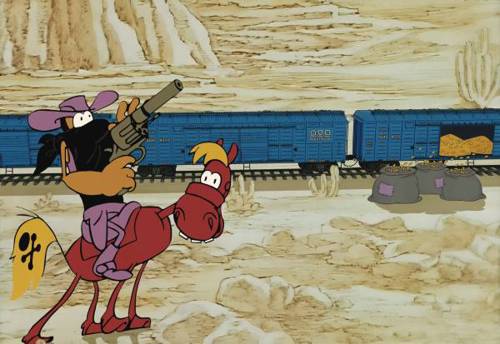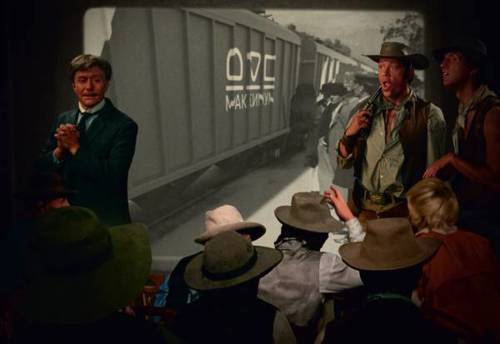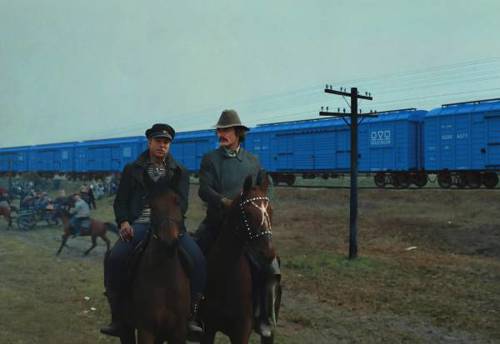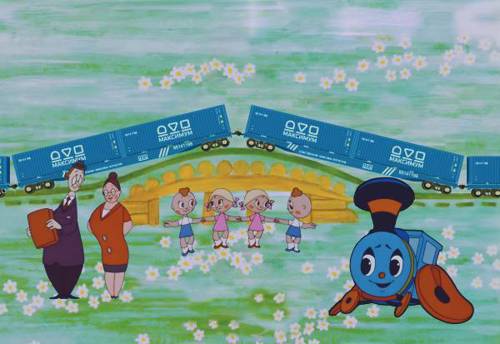
Movie calendar
Calendar 2025. Railway travel in cult films and cartoons.
Have you noticed that rail transportation has become almost as much a symbol of Russian identity as matryoshka and balalaika?
The images of roads and paths are deeply ingrained both in our natural landscape and in our cultural heritage.
For Russia, with its vast expanses, this image is especially significant.
In Gogol's time, it was certainly a three-piece bird. However, in the 19th century, steam locomotives took its place, and later trains. They have become such an integral part of our lives that if we look closely at our favorite Soviet films, we can often see how the railway serves as a familiar backdrop to our daily lives.
The sound of the wheels resembles the pulse of life — imperceptible, but vital, uniting everything together.
In the XXI century, the railway has not lost its relevance, it continues to develop successfully and attract the attention of society and masters of art.
We are pleased to realize that we maintain this pulse, that our work contributes to the living breath of modern life, continuing important traditions and meanings

Calendar 2025
"Boniface's Vacation" — Soviet animated film shot at Soyuzmultfilm studio https://souzmult.ru about the circus lion and his "vacation" in Africa. The third directorial work by Fyodor Khitruk. The script is based on the fairy tale by Czech writer Milos Matsourek "Boniface and his nephews". The screenplay is written and directed by Fyodor Khitruk, the production designer is Sergey Alimov.
How did Boniface get to Africa? What was his route? Watching the cartoon, you get the feeling that the story originates in some European city. Boniface boarded the train, on the carriage of which is written Praha – Villeneuve (Prague – Villeneuve). Villeneuve is a resort town on the eastern tip of the Swiss Riviera. It is located in the west of Switzerland, almost on the border with France. Then the train stops in some port city and transfers to a steamer. The rest of the route is anyone's guess…

January
"Girls" — is a Soviet feature film shot at the Mosfilm film studio https://www.mosfilm.ru in 1961 by Yuri Chulyukin based on the novel of the same name by Boris Bedny. The film premiered at the Central House of Cinema (CDC) in Moscow on March 7, 1962, on the eve of International Women's Day.
Filming took place in Moscow, Yalta, Perm, Tver and Ryazan regions. The village of lumberjacks, where the events take place, was filmed in the capital. Houses were built in the ravine next to Mosfilm, three hundred trees were planted and a sign "Lespromkhoz" was hung. The scenes in the forest were filmed near the village of Bobrovka in the Chusovsky district in the Urals. The actors worked in winter with severe frost up to -30 °C.
The scene with the train was filmed on a narrow-gauge railway next to a real forestry enterprise in the Ryazan region on the stretch between the stations of Spas-Klepiki and Pilevo.

February
"The Elusive Avengers" — is a Soviet adventure film directed by Edmond Keosan at the Mosfilm film Studio https://www.mosfilm.ru in 1966. The film is based on Pavel Blyakhin's novella "The Red Devils" about the adventures of four teenagers during the Russian Civil War. The film premiered on April 29, 1967. That year, the film became the leader of the rental, it was watched by 54 million viewers.
One of the most dangerous moments was the episode with the train, which the guys recapture from the bandits. A suitable place was found in the Kazakh SSR, the film crew headed by the director went there for a week, but was stuck for a month. Firstly, snow suddenly fell completely unnecessary in the frame, and secondly, we had to build a bridge that would not be a pity to burn. The director himself stood up to the control lever of the train, and the bridge collapsed immediately after a steam locomotive with four cars passed it. But then a trolley pulled out to meet the train. There was a collision, and Keosayan broke several ribs.

March
"One Cowboy, Two Cowboys" — is a 1981 Soviet hand—drawn animated film directed by Anatoly Reznikov, written by Arkady Hite. Shot by the creative association "Screen" in the studio "Multtelefilm" https://gtrf.ru .
A parody of an American western. The cartoon received a diploma from the 1989 International Film Festival in Bilbao (Spain).

April
"The Man from Kaputsin Boulevard" — is a 1987 Soviet comedy western directed by Alla Surikova based on a script by Eduard Akopov at Mosfilm Studio https://www.mosfilm.ru . The premiere of the film took place on June 22, 1987 at the Leningrad cinema "Colosseum" at the Mosfilm-87 film festival. The film was widely released on August 31, 1987. During the rental year, the film was watched by 60,000,000 viewers.
In the film, the hero shows "The arrival of the train at La Ciotat station" (French: L'Arrivée d'un train en gare de la Ciotat), a silent documentary short film from 1896; one of the first films shot and publicly shown by the Lumiere brothers. There is a legend that this video was included in the program of the first paid movie show on the Boulevard des Capuchins in Paris.
The film created the first "wandering plot" of silent cinema and was copied for a long time by operators around the world, who created their own versions of the same plot at different train stations.

May
"A friend among strangers, a stranger among his own" — Soviet film https://www.mosfilm.ru 1974 in the Eastern genre (the Soviet response to the Western). The debut work in full meter by director Nikita Mikhalkov, which was based on his story "Red Gold" with Eduard Volodarsky, written on the basis of a note in the newspaper Komsomolskaya Pravda. The main roles were played by Yuri Bogatyrev, Alexander Kaidanovsky and Nikita Mikhalkov. The film is recognized as a film classic, although it took only the twenty-second place at the box office.
The main part of the filming took place in Chechen-Ingushetia near Grozny. The dancer Mahmud Esambayev, a friend of the Mikhalkov family and one of the most famous natives of those places, advised to shoot the picture in Chechnya. He claimed that there was no such beautiful nature as he had in his homeland anywhere else.
When the episode with the train robbery was already filmed, it turned out that almost all the footage from this scene turned out to be defective. In early November 1973, the weather suddenly turned bad in Chechnya and heavy snow fell. It became impossible to shoot in such conditions, and the episode had to be re-shot in Azerbaijan, in the vicinity of Baku.

June
"The Train from Romashkov" — is a Soviet hand—drawn animated film shot at the Soyuzmultfilm film studio https://souzmult.ru in 1967. The screenplay was written by Henry Sapgir, Gennady Tsyferov, directed by Vladimir Degtyarev.
Of course, there was no blue train offering passengers to admire the sunrises in reality. However, the Romashkovo platform on the Usovskaya branch of the Belarusian direction does exist to this day. In the Soviet years, film warehouses were equipped in the building of a former church nearby, so the filmmakers were familiar with these places.
The line itself was built in the 20s of the last century. The contact network and electrification appeared there only in the late 50s, so the locomotive really went in this direction. Its power, to put it neatly, was too small and one of the ascents was difficult for him – so difficult that the passengers were dropped off and for some time they climbed on foot. But even empty, the locomotive did not always overcome the ascent on the first attempt. Naturally, this did not contribute to the observance of the schedule. That's how the story about the eternally late train formed the basis of a wonderful cartoon.

July
"Train Station for Two" — is a 1982 Soviet melodrama directed by Eldar Ryazanov based on a script by Emil Braginsky and Ryazanov. Shot by the Sixth Creative Association of the Mosfilm film studio https://www.mosfilm.ru . The main roles were played by Lyudmila Gurchenko and Oleg Basilashvili. The film was widely released on February 11, 1983. The television premiere of the film took place on November 12, 1988.
The footage of the arrival and departure of trains was taken at the Riga railway station in Moscow, which is a dead end, although according to the plot the station is in transit. Plato and Vera's overnight stay in the waiting room and their conversation before Plato's departure were filmed at the Vitebsk Railway Station in Leningrad. The passage of Plato and Vera to the standing sleeping car, as well as filming in it, were carried out near the American bridges and in the Leningrad-Moskovsky repair and equipment depot. Many scenes on the platform, as well as the passage of the main character across the bridge, were filmed at Losinoostrovskaya station. The carriage in which the main characters spent the night is the carriage of the branded Express train (in the frame where the inspectors of the wagons are walking, the inscription "Express" is visible).

August
"Relatives) — is a Soviet tragicomedy film directed by Nikita Mikhalkov based on a script by Viktor Merezhko in 1981 at the Mosfilm studio https://www.mosfilm.ru . The script of the film was written specifically for Nonna Mordyukova. "Relatives" has been lying on the shelf for a year and a half. The censors found the film dangerous and inconsistent with Soviet reality.
Nikita Mikhalkov immediately decided that the film would be shot not in pavilions, but on location. Therefore, the apartment and the restaurant in the frame are the most real. Filming on the platform took place at the railway station in Dnepropetrovsk.

September
"Crocodile Gene" — is a puppet animated film directed by Roman Kachanov based on the book by Eduard Uspensky "Crocodile Gene and his friends" and released by Soyuzmultfilm studio https://souzmult.ru December 31, 1969. In this film, widely known cartoon images appeared for the first time — the Crocodile Gena, Cheburashka and the old woman Shapoklyak. The screenplay was written by Eduard Uspensky and Roman Kachanov. Directed by Roman Kachanov.
In those years, in many amusement parks, the trailers of children's railways were painted exactly blue. Also in the 80s, the carriages of the Moscow - Rostov and Moscow — Irkutsk trains were painted in blue with a red stripe; the branded trains Moscow — Kiev and Moscow — Minsk could boast of the same blue color.

October
"The Adventures of Sherlock Holmes and Dr. Watson" — is a 1980 Soviet TV movie shot at the Lenfilm film studio https://www.lenfilm.ru Based on Arthur Conan Doyle's Sherlock Holmes stories. The premiere on Central Television was in September 1980. Filming was completed in 1986. The author of the script: Vladimir Valutsky, director: Igor Maslennikov. Starring Vasily Livanov as Sherlock Holmes, Vitaly Solomin as Dr. Watson, Rina Zelenaya as Mrs. Hudson.
Leningrad landscapes are often flashed in the film — for example, the Botanical Garden of BIN RAN (episode in the greenhouse), the exhibition hall "Flowers", the famous Cottage in Peterhof's Alexandriysky Park was filmed as the "Milverton mansion".
Vitebsk railway Station with its metal arcades and the magical play of light also starred in the famous film. During the filming, it was transformed into Victoria Station and Paddington Station ("Mortal Kombat" and "The twentieth Century Begins"). The train with Holmes and Dr. Watson departs from the first platform, the one on the far left.
In the Mortal Kombat series of The Adventures of Sherlock Holmes and Dr. Watson, the main characters get off the train to avoid being ambushed. The footage shows the children's Oktyabrskaya railway in Kolomyagi, its section that has survived to the present day.
The scenes in the train compartment were filmed in the fifth pavilion of the Lenfilm studio.

November
"Anna Karenina" — is a 1967 Soviet large—format feature film directed by Alexander Zarkhi in two parts based on the novel of the same name by Leo Nikolaevich Tolstoy. The film was shot for almost 4 years at the Mosfilm studio https://www.mosfilm.ru . Full-scale shooting took up a lot of time, when it was necessary to accurately get into the weather set by the script and Tolstoy's novel. In the USSR, it was watched by more than 40 million people. Starring: Tatiana Samoilova – Anna Arkadyevna Karenina, Nikolai Gritsenko – Alexey Alexandrovich Karenin, Anna's husband, Vasily Lanova – Count Alexei Kirillovich Vronsky. After the release of the film "Anna Karenina", it was watched by more than 40 million people in the USSR alone.
The film was shot in Moscow and St. Petersburg, and the "Italian" scenes in Crimea. The final scene of Karenina's death was filmed where Tolstoy himself described: on the railway in the Moscow region. The famous station was called Obiralovka until 1939 (after that it was a railway station).
As for the killer freight train, the locomotive was made at the Alexander Foundry, and moved at a speed of 20 kilometers per hour.

December
"Three from Prostokvashino" — is a 1978 Soviet hand—drawn cartoon directed by Vladimir Popov based on the novel by Eduard Uspensky "Uncle Fedor, the Dog and the Cat" at the Soyuzmultfilm studio https://souzmult.ru . In 1980, in the wake of the success of the cartoon "Three from Prostokvashino", director Vladimir Popov shot the continuation of the story about Uncle Fyodor and his friends — "Holidays in Prostokvashino", based on the script by Eduard Uspensky, and in 1984 — the cartoon "Winter in Prostokvashino". The screenplay was written by Eduard Uspensky, directed by Vladimir Popov.
Uncle Fyodor's family lives in Moscow. During the "Holidays in Prostokvashino" Uncle Fyodor's parents took the Moscow-Sochi train. But where is the village of Prostokvashino? Pechkin signs his letter as follows: "Goodbye. The postman of the village of Prostokvashino, Mozhaisk district." The village is located on the banks of the river in the Moscow region near Moscow, as it can be reached by direct train or just by skiing.
The real and very small village of Prostokvashino is located in the Tonkinsky district of the Nizhny Novgorod region, but at the time of the creation of the first story, Eduard Uspensky did not know about its existence.

 Заказать
Заказать Personal
Personal















